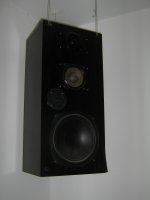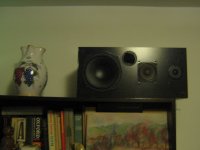Such as, and how are you defining 'better' (genuine question)? I can think of lots of alternatives, but I try to avoid a blanket categorisation that any one is 'better' than another. Specific circumstances or requirements, certainly.
As previously noted, most Novak / T/S derived vented boxes are not technically bass reflex enclosures. Although that's just me being a pedant. 😉
As previously noted, most Novak / T/S derived vented boxes are not technically bass reflex enclosures. Although that's just me being a pedant. 😉
I do not understand the problem, if bass reflex is done right it is a very good solution. Can be very cost effective too.
The issues normally arise sometime during planning and development, cutting corners usually based on aesthetics and/or economy.
Edit:
Scott, I would be most interested if you would point out the major differences between the various vented designs using some kind of port or tube. I must admit it's all a huge grey lump called "TL variations" to me, some implementations are good, others "less good"...
The issues normally arise sometime during planning and development, cutting corners usually based on aesthetics and/or economy.
Edit:
Scott, I would be most interested if you would point out the major differences between the various vented designs using some kind of port or tube. I must admit it's all a huge grey lump called "TL variations" to me, some implementations are good, others "less good"...
Last edited:
I believe the term 'bass reflex' applies to the method used in the pioneering days of tuning the port to match the the resonant frequency of the bass driver.
This results in the characteristic 'humps' in the impedance curve on either side of resonance having equal amplitudes.
We've now moved on to designing vented boxes according to T/S parameters.
This results in the characteristic 'humps' in the impedance curve on either side of resonance having equal amplitudes.
We've now moved on to designing vented boxes according to T/S parameters.
(genuine question)?
Perhaps I should qualify my questions like that. 😉🙂🙄
I don't think a well-impemented port tube vent bass reflex can sound as good as a well-implemented tapered TL. That's my opinion of course, but I think others will agree that a TL sounds better from standpoint of not only better bass, it allows the driver to sound cleaner in the midrange.
Fair enough. I generally prefer a QW load if it's available; that being said, I don't necessarily regard variations on the QW theme as being automatically superior to a quality Helmholtz either. Sometimes, to be sure. But this is application specific, so we're dealing with a question of alignments & damping, and also basic matters of whether you can achieve the target alignment with both approaches, within whatever dimensional constraints may be in place. Vented Helmholtz-based boxes often get a bad reputation through over-simplistic design and excessive reliance on specific alignments.
Re 'bass reflex', strictly they were what Thuras & his successors created, i.e. Helmholtz derived boxes that do not use the electrical filter theory methods created by Novak, & refined by Thiele & finally Small. Most were tuned to Fs, but there was plenty of adjustment available -it just had a greater emphasis on the empirical as modelling wasn't as precise. The advantage (or disadvantage) of the later filter-theory derivations is that you can consistently hit given alignments or extract maximum extension from the minimum box size; the price is acoustic efficiency.
Re 'bass reflex', strictly they were what Thuras & his successors created, i.e. Helmholtz derived boxes that do not use the electrical filter theory methods created by Novak, & refined by Thiele & finally Small. Most were tuned to Fs, but there was plenty of adjustment available -it just had a greater emphasis on the empirical as modelling wasn't as precise. The advantage (or disadvantage) of the later filter-theory derivations is that you can consistently hit given alignments or extract maximum extension from the minimum box size; the price is acoustic efficiency.
Perhaps I should qualify my questions like that. 😉🙂🙄
Speaking purely for myself, I find it can help avoid ambiguity or causing offense when none is intended, which is usually a good thing.
I would also note that based upon the provided picture our original poster has hung these speakers from the ceiling in a corner of a room. Could room nodes be having an effect here with our perceived "one note" bass response?
With the lack of any real information this thread is pretty useless other than to demonstrate that declaring such absolutes as "design X is always better than design Y" is foolish at best and fairly ignorant in general.
But feel free to continue feeding the troll as long as you like.
-bill
With the lack of any real information this thread is pretty useless other than to demonstrate that declaring such absolutes as "design X is always better than design Y" is foolish at best and fairly ignorant in general.
But feel free to continue feeding the troll as long as you like.
-bill
good idea wrankin. will do ASAP = after i buy new cables for that as the current one is in the wall. my father was obsessed with stereo so he did mount those speakers wide as possible.
me on the other hand listens also to mono so no problem when i put that box more near to the other.
will let you know after i buy new cable...
edit: i found one so i did put both speakers lower but on a cabinet. currently testing.
me on the other hand listens also to mono so no problem when i put that box more near to the other.
will let you know after i buy new cable...
edit: i found one so i did put both speakers lower but on a cabinet. currently testing.
i did put that down now further from the ceiling but still on a cabinet (use that to enhance bass on ****** speakers).
tested now the sound with 2 tracks:
new + improved
traveling
1. it is better to have them further from ceiling
2. the bass is still more exact when i play it with the bass reflex holes closed. with open holes it plays loud but surpresess surrounding bass frequencies.
so probably i should work on sealing that cabins properly off.
tested now the sound with 2 tracks:
new + improved
traveling
1. it is better to have them further from ceiling
2. the bass is still more exact when i play it with the bass reflex holes closed. with open holes it plays loud but surpresess surrounding bass frequencies.
so probably i should work on sealing that cabins properly off.
Attachments
Or, rather than put a sock in it, you could convert the cabinet into a proper aperiodic enclosure:... so probably i should work on sealing that cabins properly off.
Aperiodic Enclosures - Great Sound Stereo Speaker Manual
Let's make the image of e3k's 'no name' speaker more accessible by showing it in an attachment.
Having them hanging a few inches from the upper corner of a room isn't exactly a recipie for quality sound, and about the worst position it's possible to stuff a speaker into which isn't designed for 1/8 space loading.
coarse screenwire - yes i have some. do i fill only the tube or should also but the cloth inside the speaker?Or, rather than put a sock in it, you could convert the cabinet into a proper aperiodic enclosure:
Aperiodic Enclosures - Great Sound Stereo Speaker Manual
There's some surgery required!
Remove the tube. Enlarge the hole which is left to the correct area to suit the volume of the enclosure (10 square inches per cubic foot).
Staple the screenwire over the interior of the hole, compress a couple of layers of fibreglass into the hole, then cover it over at the front with more screenwire.
Read the link carefully for the full instructions.
Remove the tube. Enlarge the hole which is left to the correct area to suit the volume of the enclosure (10 square inches per cubic foot).
Staple the screenwire over the interior of the hole, compress a couple of layers of fibreglass into the hole, then cover it over at the front with more screenwire.
Read the link carefully for the full instructions.
As useful as this may be, I'd point out that aperiodic is not an intermediate measure between closed and vented.
Aperiodic is more akin to sealed than ported.
Anyhoo... If he don't like it he can seal up the hole! 😉
Anyhoo... If he don't like it he can seal up the hole! 😉
Sa brura!
...
(Said the bride!)
Sorry! So hard to resist.
At any rate, trying Aperiodic is probably one of the easier solutions. And especially so, since very low manufacturing cost vented speakers commonly use somewhat underwhelming magnet strength on the drivers so the qts is often higher than recommended values for bass reflex or most easily simplified TL variants, it is a fire-sure recipe for boomy one-note bass. Aperiodic, sealed or dipole is better for such drivers.
...
(Said the bride!)
Sorry! So hard to resist.
At any rate, trying Aperiodic is probably one of the easier solutions. And especially so, since very low manufacturing cost vented speakers commonly use somewhat underwhelming magnet strength on the drivers so the qts is often higher than recommended values for bass reflex or most easily simplified TL variants, it is a fire-sure recipe for boomy one-note bass. Aperiodic, sealed or dipole is better for such drivers.
Hi e3k, the speaker is not in optimal position and orientation so it will sound bass heavy if you listen seated. Proper speaker and listening position might be enough to make that bass reflex feature usefull. If thats the position you want to keep the speakers, I believe you are correct, too much bass and you should block the port. Your ears will tell if balance between highs and lows is too much off. Have fun! 🙂
Last edited:
- Home
- Loudspeakers
- Full Range
- my no name speakers with bassreflex suck

